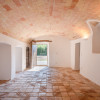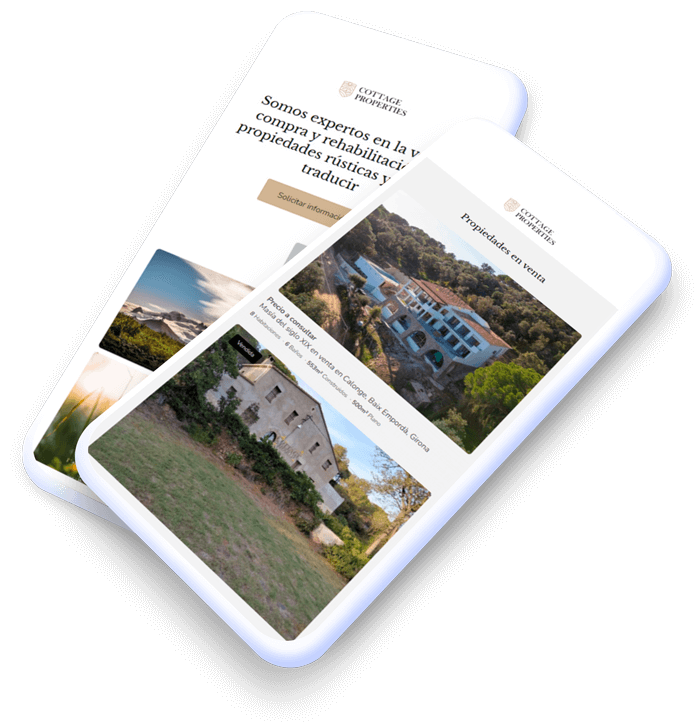What is a masía? Everything you need to know in 10 key points
Post published in Rural properties
According to Spain's official dictionary the word 'masía' means a "farmhouse" with "agricultural and livestock land" – but there is so much more to discover.

Beyond Gaudí's works, the masía is the most striking form of Catalan architecture.
But…why aren’t they as well known?
At the end of the 19th century, masías fell into abandonment due to industrialisation and rural depopulation.
Yet, in the 21st century, masías have experienced a revival and now count themselves among:
The most expensive luxury homes sold across Spain
The location for world-renowned hotels, restaurants, and businesses
Cultural Heritage Sites (BIC) of the highest importance
And that’s not all.
The masía, with its historic charm and expansive grounds, has become a sought-after refuge for homebuyers seeking luxury, peace, and vast spaces to enjoy a private life or become self-sufficient.
But what exactly is a masía, and what are their features?
In this article, we’ll tell you everything you need to know about masías in Spain.
10 key facts and curiosities about masías in Spain
1. Meaning of the word ‘masía’
The word masía describes a rustic, isolated house, surrounded by extensive land dedicated to farming and livestock.
In Spanish, the term masía is borrowed from Catalan. It exclusively refers to rural estates in the present-day lands of the former Kingdom of Aragon: Catalonia, the Valencian Community, the Balearic Islands, and southern France (Provence and Languedoc).
But to fully understand the meaning of a masía, it’s essential to know three specific words.
According to the Gran Diccionari de la Llengua Catalana:
A mas is a "traditional agricultural estate” that includes “forests, pasture, and farmland.”
A masia is the “central building of a mas.”
A masover is the “person who works a mas” and “typically resides in the masía.”
Therefore, a masía is not just a residence.
It referrs to the traditional agricultural estates where the same family cultivated the land and typically lived a self-sufficient existence.

2. The word ‘masía’ comes from the Roman era
The word masía has its roots in the ancient Roman farmhouses that occupied the lands of Roman Hispania between 218 BC and 476 AD.
This origin is clear in the word masía itself.
Masía comes from the Latin mansus, meaning "country house" or "rural property." The term mansus derives from the Latin verb manere, which is also the root of the word “permanence” in English and Spanish (permanecer).
In some cases, this Roman ‘root’ is physical.
For example, the masía of Can Sentroma in Tiana, Barcelona, is built directly on top of an ancient Roman villa.

3. The 15 main features of a masía
Masías in Spain are each unique, adapted to their surroundings and their uses. However, they share some common characteristics that define them.
These include:
Detached properties: Masías are always detached properties, sometimes accompanied by outhouses, barns or other agricultural structures.
Extensive grounds: Masías are typically surrounded by large expanses of land, often up to 10,000 m² or even more.
Agricultural connection: Traditionally, all masías were tied to agricultural and livestock activities.
Two-storey layout: The ground floor was used for agricultural and livestock production, while the upper floor served as the family’s living quarters. A third floor, if present, was used as a granary.
Oil mills or wineries: Many masías included a specific area for producing olive oil or wine, with presses and vats, reflecting their crucial role in the rural economy of the region.
South-facing orientation: They are oriented southwards to maximise winter sunlight.
Gabled roof: The roof extends outwards, protecting the masía’s walls from the elements.
Stone materials: Built with natural stone, often sourced locally. In mountainous areas, rough or hewn stone was used, while adobe was used in regions without stone.
Stone entrance doors: Masías built before the 16th century have a voussoir arch (wedge-shaped stones with a central keystone) while those built up to the 18th century usually have a lintel (horizontal stone or wood).
Small and scarce windows: Older masías typically have few and small windows, especially on the ground floor, to insulate against winter cold, summer heat, and for added security.
Thick walls: The walls are generally between 30 and 50 centimetres thick.
Wooden beams: The roof is supported by wooden beams placed perpendicularly to the facade.
Tiles or slate: Roofs are covered with tiles or slates. In the Pyrenees and other mountainous areas, slate is commonly used, while nearer the coast, roofs tend to have tiles.
Defensive towers: Some masías, especially in coastal or border areas like Valencia, had towers or outer walls for defence.
Central courtyard: Some masías feature an interior courtyard or common area that connects the different parts of the building, providing a protected space for family and work activities.
For more information, see our article on the 17 main characteristics of Catalan masias.

4. Outside Catalonia, a ‘masía’ is known by different names
In other parts of Spain, there are traditional rural buildings similar to a masía. These are houses dedicated to agricultural and livestock activities, surrounded by extensive land.
However, they are known by other names.
Below is a list of terms used in different regions of Spain to refer to agricultural buildings similar to a masía:
Cortijo: Typical of southern Spain, especially in Andalusia, a cortijo is a farming estate that includes areas for crop cultivation and livestock breeding.
Granja: Common in northern Spain, particularly in Galicia and Asturias, a granja is a property dedicated to agriculture and livestock.
Casa de labranza: Popular in the north, especially in Asturias and Cantabria, a casa de labranza is a rural house dedicated to farming.
Alquería: Found mainly in the Valencian Community and Murcia; an alquería is a farmhouse with nearby farmland.
Finca: Used throughout Spain, finca refers to a rural property, which can include a house and agricultural or livestock land.
Hacienda: Common in Andalusia and Extremadura, a hacienda is a large rural estate dedicated to agriculture and livestock, often of significant size.
Masadas: Typical of Aragon, the term masada refers to a farming estate with a house and land, similar to a Catalan masía.
Possessions: In the Balearic Islands, the term possessions refers to large rural estates that include a house and farmland.
Casonas: In Cantabria and the Basque Country, a casona is a large country house, usually stone-built, intended for rural life and agriculture.
In other countries outside Spain, there are also rural properties similar to a masía, known by other names.
Some of the most notable terms include:
Podere: In Italy, especially in Tuscany, a podere is a farming estate with a farmhouse, surrounded by vineyards and olive groves.
Masseria: In southern Italy, particularly in Apulia, a masseria is a large agricultural estate with a fortified house and land.
Bauernhaus: In Germany and Austria, a Bauernhaus is a typical farmhouse dedicated to agriculture and livestock.
Farmhouse: In English-speaking countries like the United Kingdom and the United States, a farmhouse is a rural house that is part of a farm.
Bondgård: In Sweden, a bondgård is a traditional farmhouse linked to agricultural activities.
Fángzi (房子): In China, a fángzi in rural areas is a traditional farmhouse, often part of a family estate.
Château: In France, a château is a large property that may include farmland or vineyards and often has a stately character. Although château generally translates to “castle” in Spanish, it can also refer to a rural house or estate dedicated to viticulture.
Rancho: In Latin America and the southwestern United States, a rancho is a rural property mainly dedicated to livestock breeding.
Quinta: In regions like Galicia and Portugal, a quinta is a rural property with a house and land for agricultural production.

5. The oldest continuously inhabited masía dates back to 1182
Masías in Catalonia are typically dated between the 10th and 19th centuries. Although masías with a history of 1,000 years can still be found, most are either in ruins or have been uninhabited for decades during their history.
But there’s an interesting exception: the oldest continuously inhabited masía in Spain.
It's a property called Can Rovira in the village of Sant Miquel de Campmajor in Pla de l'Estany, Girona, Catalonia.
Can Rovira dates back to the year 1182 and has been the home of the same family (the Planes-Rovira) for 26 generations. Although the family has carried out renovations to keep it habitable, it still respects the original layout.

6. The masía was inherited by the firstborn son
If the history of Can Rovira, passed down through 26 generations, surprises you, it’s worth knowing that this practice was customary in Catalonia.
The Catalan tradition of the hereu (firstborn son) and the pubilla (firstborn daughter) involved passing the entire masía estate to the primary heir. This custom prevented the land from being divided among multiple children.
Other children were given the legítima, 25% of the inheritance, as support to pursue education or alternatives such as entering religious orders.
This system contributed to the continuity of masías and the economic stability of rural Catalan families.
7. There are more than 22,000 masías in Catalunya
As in other parts of the developed world, the industrialisation of the 19th century led to a gradual abandonment of rural areas. However, the abandonment of masías in Catalonia was worsened by an epidemic.
Phylloxera, an insect that attacks vine roots, arrived in Girona in 1879 and within just 13 years destroyed all Catalan vineyards. While other pests might cause the loss of one or two harvests, phylloxera killed both the plants and the new vines.
According to data from the Agronomic Advisory Board, phylloxera destroyed:
119,000 hectares of vineyards in Lleida
116,000 hectares of vineyards in Barcelona
111,000 hectares of vineyards in Tarragona
39,000 hectares of vineyards in Girona
The losses were estimated at around 350 million pesetas (approximately €1.8 billion today). This was a major factor in rural depopulation and the abandonment of traditional Catalan masías.
According to a study by demographers Albert Esteve and Miquel Valls, there were around 20,000 masías in Catalonia in 1860.
Today, there are more than 22,000 masías in Catalunya recorded in municipal inventories. Many of them are in ruins, but in almost half of Catalan municipalities, there are regulations to promote rehabilitation projects without losing valuable historical and architectural elements.

8. These are the 5 most globally recognised masías
Fortunately, not all masías have been left to total abandonment.
During the 20th century, many masías were carefully preserved, restored, and renovated. Today, these masías have been transformed into restaurants, private gardens, boutique hotels, and even football academies.
Among the most famous masías are these five:
La Masía (Barcelona Academy): The famous FC Barcelona football academy was located in a historic masía: Can Planes. Built in 1702 and originally used for dryland farming – mainly olives – and vineyards, it housed the FC Barcelona residency and academy from 1978 to 2011, training legendary talents like Lionel Messi within its walls.
Mas d'en Bruno: This resort, awarded "Best Resort in Europe" in 2024, is a 19th-century masía in the heart of Priorat in Tarragona, surrounded by vineyards. Condé Nast Traveler notes that its former olive oil mill has been converted into a stylish spa, and the surrounding lands belong to the renowned Clos de l’Oblac.
Masía El Altet: Located in Alcoy in the Valencian Community, this masía produces high-quality extra virgin olive oil. It has won multiple international awards and is known as the "most awarded olive oil in the world."
Mas de Torrent: This boutique hotel has made headlines for its popularity among celebrities like Shakira, Victoria Beckham, and Kylie Minogue. Situated in the heart of Baix Empordà, it is the only 5-star hotel in the area.
Les Cols: This two-Michelin-starred restaurant in La Garrotxa, Girona, is based in an impressive 15th-century masía. It is known for its head chef, Martina Puigvert, who won the "Young Chef 2024" award in the Michelin guide at the age of 29. Martina works alongside her mother, Fina Puigvert, who was born in the same masía.

9. Celebrities who have bought a masía in Catalonia
Masías have also become highly sought-after properties among Spain’s rich and famous. The privacy offered by a Catalan masía is obvious – often there are no neighbours, as they are surrounded by their own extensive grounds.
These are masías that have been renovated and equipped with modern amenities to suit a contemporary, luxurious lifestyle.
Here are some of the most famous owners of a masía in the Catalonia region:
Rosalía and Rauw Alejandro: The famous singer and her partner acquired Masía Morera, an 18th-century property on the outskirts of Manresa, Bages. With 30 hectares and over 2,600 m² of living space, this masía cost nearly 2 million euros.
Paz Padilla: The widely loved actress and comedian owns Can Miquelet, an 18th-century masía in Girona, surrounded by over 5 hectares of land in Vilamarí, Pla de l'Estany. It’s her second home, which she rents out for events when not in use.
Josep Joan Bigas Luna: The acclaimed film director owned a masía in La Riera de Gaià, Tarragona. He's famous in Spain for films like Jamón, Jamón and The Ages of Lulu. After purchasing the masía as a holiday home, he eventually renovated it and turned it into his main residence. In 2018, it was listed for sale at around 750,000 euros.
Jordi Pujol: The former President of the Generalitat of Catalonia owns a 14th-century masía in La Cerdanya, Girona. The Pujol family carried out such a special restoration that they included a photographic exhibition of the process within the masía.
Sandro Rosell: The former president of FC Barcelona owns a masía in Corçà, Baix Empordà, Girona. This property includes 809 m² of living space, several outbuildings and pavilions, all on 3 hectares of land, valued at 4.2 million euros in 2009.

10. A masía was “the most expensive house in all of Spain” in 2022
Masías have come a long way.
From near abandonment in the late 19th century, they have become some of the most expensive properties on the real estate market in Spain in recent years.
One example is Mas Floris.
This 18th-century masía made headlines in 2022 as "the most expensive house in Spain" on the market at that time.
Located in Pals, Girona, Mas Floris spans 30 hectares of fenced land, with 20 en-suite bedrooms, accommodation for up to 40 people, and multiple luxury facilities.
These include a summer kitchen, bar, chill-out area, children’s playroom, library, garden designed by Fernando Caruncho, sculptures, vegetable garden, vineyard, tennis and padel courts, and even 8 golf carts.
The sale price was not disclosed…
But considering that another 2022 ranking listed the most expensive house in Spain at €23 million, one can imagine the asking price for Mas Floris.

If you’re interested in buying a masía, read this first
It’s easy to dream of owning a masía.
But it’s important to know that this type of property is unique and presents different challenges from a conventional home. For starters, many masías need renovations – sometimes minor, sometimes extensive.
Take note.
The Generalitat of Catalonia closely oversees the restoration of many masías, as they are considered assets of archaeological interest. Renovations must be carried out with historical materials and in harmony with the natural surroundings.
Having experts who understand the regulations is crucial.
At Cottage Properties, we have over 25 years of experience in the buying and selling of masías and rustic estates across Catalonia and all of Spain. Our team of more than 70 people is currently dedicated to restoring these homes.
So, if you want to visit and buy a masía in Catalonia, we offer an unparalleled service.
Browse the Finest Portfolio of Masías for Sale in Catalonia
Are you interested in seeing the best selection of masias for sale in Catalonia?
Cottage Properties is one of Spain’s leading estate agencies specialising in the sale of luxury masías and country houses. We are fully API-certified real estate agents and provide a comprehensive service, especially for foreign buyers.
We invite you to explore the available properties and find the perfect masía for you.
Feel free to contact us to schedule a viewing or receive personalised recommendations.
FAQ
What is a Spanish masia?
A masía is a traditional rural estate found in regions of Catalonia and other areas that were part of the ancient Kingdom of Aragon. Typically, a masía is a rustic, isolated house surrounded by extensive land dedicated to agriculture and livestock, often built from local stone with thick walls and small windows to suit the environment. These unique properties have gained popularity for their historic charm, privacy, and luxurious restoration potential.
Why is Barca Academy called La Masia?
FC Barcelona's football academy is known as La Masia because it was originally housed in the historic masía of Can Planes, an 18th-century farmhouse repurposed in 1978 to train young football talent. The name pays homage to this historic site, where legendary players like Lionel Messi began their careers, symbolising a deep-rooted connection between FC Barcelona and Catalan heritage.
What is a masia in English?
In English, a masía refers to a farmhouse or rural estate, typically featuring traditional stone construction and surrounded by farmland. It's a word exclusively used to refer to rural estates in the Catalonia region of Spain. Other parts of the country have their own terms, like cortijo in Andalucía or finca in many other areas.
Post published 23/10/2024 in Rural properties



